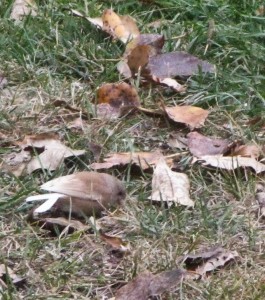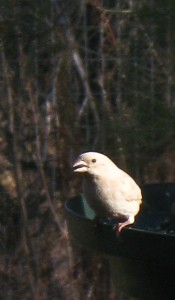Despite autumn wind
Cottonwood’s last leaves hang on
Flaming defiance.
The first time I spotted it, it drew my eye like a magnet, the way anything unusual or unexpected might. A flash of white amidst the fluttering of grey and brown and the rufus red bellies of house finches. It turned its tail toward me and scooted around the feeder to the back, out of sight, then reappeared on the other side, a creamy white bird I’d never seen before, could not even remember hearing about. I looked again, then ran to get my camera, but when I returned he was gone.
In my eagerness to “capture” this unique bird I hadn’t even paused long enough to notice what kind of beak it had, the shape of it’s body, nor even its size. The image in my mind began to fade until it was nothing but a ghostly apparition.
I grabbed my field guide and began flipping through the pages. In spite of the fact I hadn’t taken notice of even the most fundamental clues in order to narrow it down to family, I was certain I’d have no trouble finding it. After all, how many white birds could there be? I went back and forth through the guide, but discovered only one bird with the right plumage, the snow bunting. But they appeared to be much bigger than the bird I’d seen.
I called my expert birding friend and asked what he thought. His only idea was the Snow Bunting as well, but the more questions he asked the less likely it seemed. “There’s one other possibility,” he said. “It was with a flock of house finches? It might be a leucistic house finch, though leucistic birds are very rare.”
I’d never heard of these albino deviants before and further research revealed that, though rare, leucistic variants existed for nearly all species of birds.
In leucistic birds the plumage lack melanin pigment caused by a genetic mutation. Sometimes the white patches are small and result in a kind of piebald appearance. Sometimes most all of the feathers are affected resulting in either a very washed out look, or even the total white of an albino. In true albino birds all of the pigments are affected, giving them red eyes and pale beaks, legs and feet
Such birds are rare because their unusual coloring can make them a target for predators. The luecism can also weaken their feathers, since melanin is an important structural component of feathers. These diminished feathers aren’t as insulating and can reflect heat, which makes it hard for the birds in the icy cold of Montana winters. Their unusual plumage also makes it hard for the birds to attract a mate and pass on their genetic mutation.
No one knows what causes this mutation, but an article in the Houston Chronicle cites a study done after the meltdown of Chernobyl in 1986. There was tenfold increase in the incidences of leucism in barn swallows near the plant.
 I never saw the leucistic finch again that winter, but this winter another small, pale bird showed up at the feeder with a flock of juncos . This time it did have some coloring, though very washed out and it’s tail was pure white. I resisted the urge to run for my camera the first time I saw it and instead studied it through the binoculars until it flew off into the backwoods. It continued to show up with the other juncos for several weeks, but I haven’t seen it since December.
I never saw the leucistic finch again that winter, but this winter another small, pale bird showed up at the feeder with a flock of juncos . This time it did have some coloring, though very washed out and it’s tail was pure white. I resisted the urge to run for my camera the first time I saw it and instead studied it through the binoculars until it flew off into the backwoods. It continued to show up with the other juncos for several weeks, but I haven’t seen it since December.
 However, just before Christmas another white bird caught my eye and this one was with a flock of house finches. I studied it carefully, noting it’s size, shape and beak and determined it was indeed a leucistic house finch, though it is doubtful if it was the same one I spotted last year. And this one appears to be a true albino, with its white beak and pale legs and feet.
However, just before Christmas another white bird caught my eye and this one was with a flock of house finches. I studied it carefully, noting it’s size, shape and beak and determined it was indeed a leucistic house finch, though it is doubtful if it was the same one I spotted last year. And this one appears to be a true albino, with its white beak and pale legs and feet.
Which leads me to wonder—why, with luecism being so rare, have I now seen three such birds in just a little over the year? The finch has been returning to the feeder regularly and this time I was finally able to get a picture of him. But I learned my lesson. Look first—really look, and then, if there is an opportunity, try to capture it with the camera.
THE POND
Fog lies heavy in the river bottom in the civil twilight,
that hour before dawn where a pond sits
in the center of a cloud of unknowing,
her canvas patiently blank, a veiled white mirror.
Slowly the sun crests the ridgetops
The veil brightens incrementally
Something sparks on the surface of her thoughts
as a thousand minuscule droplets of water
bounce the first glimmers of light through the forest.
Faint brown sketched lines of tree trunks and limbs
emerge from the mist, merely giving a hint of their form through the haze.
As they seemingly creep toward her,
lines criss-cross the canvas in a growing web,
cast out to capture the impressions just beginning to take shape.
The artist waits in perfect calm,
though the sun is half way up the sky now,
a pale specter behind the screen of cloud slowly lifting
And then the first spears of grasses
lightly pierce the bottom of the scene.
She does not become ruffled, but remains still,
waiting for whatever is before her
to reveal itself in its own time.
The growing heat of mid-day at last begins to burn away the fog
leaving behind glistening splashes of color
Struggling to keep up with the flood:
sage and grass, moss and spruce, celandine and leaf,
the artist fills her canvas with a wash of variegated shades of green.
Sky blue and dandelion fluff white, earth brown, redosier red,
ocher bark and silver-gray trunks
and then still more, golden rod yellow, seed pod taupe, flax blue, and scarlet gilia
it is all there reflected on the canvas in lifelike detail.
She admires her nearly perfect reflection until
an afternoon breeze begins to play
among the top branches of the ponderosas.
It’s gentle touch across the artist’s face
shakes loose her attachment to her creation.
She slowly begins to smear her paint
letting the wind direct her hand so that the colors ripple
until the forms of tree and bush, grass and sky
are barely discernible in the swirling kaleidoscope of the canvas.
And there in the fathoms of shifting light and the winds of change,
the painting reveals, just below the surface,
a shimmer of impermanence,
the deep current flowing through everything.